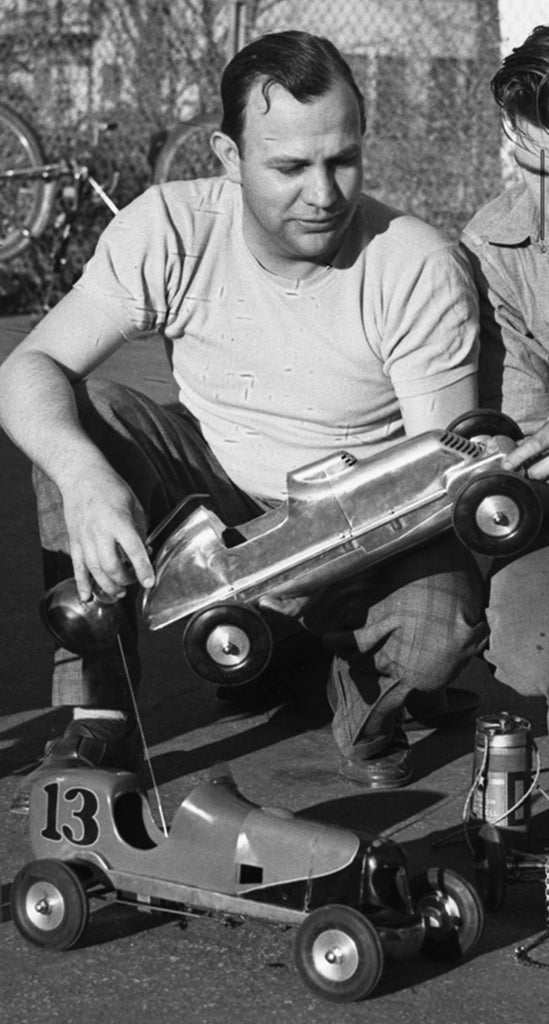
Jim Thorpe, American Olympian and later pro football Hall of Famer, competing in track and field for Team USA at the 1912 Summer Olympics in Stockholm, Sweden.
The humble T-shirt does it all: it‘s an undershirt and a standalone, comes in plain and printed varieties, even functions as wearable advertising. Tees have been a style icon for decades now, but when did they first become popular? If you look online most articles will tell you that tees became staples after World War II, and especially in the 1950s.
This July 13, 1942 issue of LIFE magazine is often even pointed at as the planting the seeds for when it started to bevoke socially acceptable to don a T-shirt in public as a standalone shirt and not simply as underwear:

And then came the 1950s, when Marlon Brando and James Dean wore tees on screen and made them cool:


Is this commonly held belief true, though?

The short answer is: no. The long answer starts with a brief history of the T-shirt that takes us back to the 1900s and 1910s. That’s when the first modern, white tees were issued as undershirts to US Army soldiers and Navy sailors and were also being worn by athletes.
At this point these tees were strictly undergarments or sports uniforms, and were made of wool and later cotton. Troops and sailors wore them as standalones in hot conditions when on base or on deployment, but it's not something they would have been caught wearing into town.
The T-shirt issued to enlisted men was similar to the singlet shirt already worn by track and fields athletes of the time, most notably at the Summer Olympic games.

Meyer Prinstein, Greater New York Irish Athletic Association, doing the broad jump at the 1904 Summer Olympics in St. Louis, Missouri.
In the same year, 1904, the Cooper Underwear Co. now somewhat famously marketed a crew neck undershirt as “bachelor undershirt” that stood in contrast to the commonly worn henley undershirts of the time:

Following suit, in the 1908 Olympic games, athletes’ shirts took on all the characteristics of modern T-shirts, including sleeves that extended to the biceps and a crew neck collar, the name of which is a reference to their naval origins.
The cover of the program for the 1908 Olympic Games in London clearly shows an athlete wearing a modern white T-shirt:


The trend continued four years later at the 1912 Summer games in Stockholm:

At this point T-shirts were still worn only in sporting or military situations, but the general public was wearing comparable wool shirts as part of their swimsuits.

 Beachgoers on the shore at Atlantic City, New Jersey in 1910. Image courtesy of Shorpy.
Beachgoers on the shore at Atlantic City, New Jersey in 1910. Image courtesy of Shorpy.
T-shirts gained very little traction as casual wear in the 1920s but that changed in the 1930s, especially the late 1930s. That said, here’s an undated photograph listed as having been taken between 1925 and 1931, although the accuracy of that claim is debatable:

Note not just the tee but also the chinos, another article of clothing that’s often believed to have only become popular after World War II, a myth I busted previously.

Actor John Hall, above, is seen wearing a striped tee in 1938, showing that casual tres were worn before the end of WW2.
Plain tees were first sold in the Sears 1938 Spring/Summer catalog as “GOB” shirts, a reference to enlisted Navy sailors.


Tees quickly found favor with the younger crowd; here’s a child wearing a striped one in 1938:

By 1940, tees had long since gone mainstream as everyday wear, they simply weren’t as prevalent as they are today and weren’t worn prominently by a style icon in a popular film or on a magazine cover just yet, hence the misconception that tee-wearing was a post-war phenomenon.
 Knit striped tee being worn in Belle Glade, Florida, 1940.
Knit striped tee being worn in Belle Glade, Florida, 1940.
The following images are all courtesy of the UTA Libraries Special Collection:

Terrycloth tee, 1940.

Patterned knit tee, February 1940.

Striped tee, 1940.

Striped tee, 1941.


US Post Office workers, 1941.

Soldiers playing backgammon at Fort Wolters, Ft. Worth, September 1941.

Plain white terry cloth tee, 1941.

4-H camping trip, 1942.

Madill Provisional Internment Camp, Madill, Oklahoma, 1943.
As is evident by now, the commonly held belief that tees only became popular after WW2, isn’t entirely accurate. Consider this myth busted.
